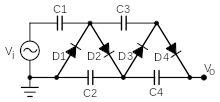The Cockcroft–Walton Multiplier (CWM) generator, or multiplier, is a type of electronic circuit that multiplies a high AC voltage into a higher DC voltage by a clever arrangement of diodes and capacitors, It was named after the British and Irish physicists John Douglas Cockcroft and Ernest Thomas Sinton Walton, who in 1932 used this circuit design to power their particle accelerator and splitting the atom for the first time. The circuit was discovered in 1919, by Heinrich Greinacher, Cockcroft–Walton circuits are still used in particle accelerators. They also are used in everyday electronic devices that require high voltages, such as x-ray machines, microwave ovens and photo copiers.
Wiki Article: https://en.wikipedia.org/wiki/Cockcroft%E2%80%93Walton_generator

The circuit acts as a charge pump. As V1 changes from +ve to -ve, each capacitor is charged up in turn by the arrangement of diodes. This allows the voltage V1 to charge both Capacitors C2 and C4 to V1’s potential via C1 and C3.
As the output is taken across both C2 and C4 in series, this doubles the input voltage.
Longer chains can be constructed where roughly every two capacitors and two diodes add another “V1” voltage to the combined output.
For the any small laboratory the advantage to using a CWM rather than a VDG is reliability. As the CWM does not rely on a chemical bond forming/releasing (the tribo electric effect) or any mechanical interaction, its is much more reliable and will continue to work in situations where VDG’s fail. (usually dirty or high humidity settings)
If you are demonstrating how a VDG works and triboelectric charging, then a VDG is ideal, but If you want to demonstrate high voltage interactions then you need something more reliable.

